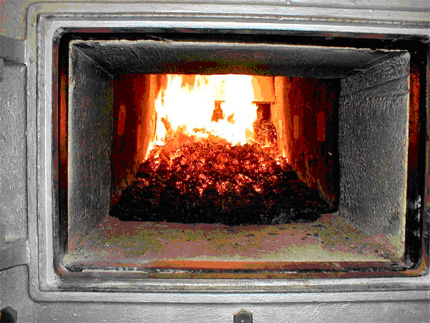
|
|
Biomass Conversion ResearchBiomass conversion to produce energy can be a cost-effective solution to address major environmental issues such as waste disposal and climate change. Scientists and engineers at the CANMET Energy Technology Centre - Ottawa (CETC-Ottawa) work closely with industry representatives on advanced biomass conversion technologies to reduce costs, emissions and increase operating efficiencies. CETC-Ottawa collaborates with industry, government representatives and international working groups to increase the use of safe, non-polluting biomass combustion systems by developing technical protocols and standards. Biomass EnergyAs a sustainable and climate change neutral fuel, biomass is increasingly being seen as a competitive energy source. Almost 6% of the total energy consumed in Canada is currently produced from biomass sources. The majority of this production is in the pulp and paper industries, which use their own residues to produce process steam and electricity. The combustion of wood for residential heating makes up the difference. There are however numerous biomass feedstocks that could be used for industrial and commercial energy production; residues from the forestry industry (harvesting through to final processing), agricultural residues and municipal solid wastes (MSW). Special energy crops such as hybrid poplar, willow and switchgrass can be grown in plantations.
Canada has the potential to triple its current biomass energy production. The next steps are critical in continuing technical progress in emissions reduction, improvement in conversion efficiency and demonstration of integrated multi-function facilities. Such developments will spur the growth of biomass markets and infrastructure - key components in expanding the bioenergy economy.
A Centre of Excellence in Stationary-Source CombustionThe Biomass & Renewables Research Program is part of CETC-Ottawa's Clean Electric Power Generation (CEPG) Group, Canada's centre of excellence in stationary-source combustion. The Group has a research staff of fifty-plus scientists, engineers and technologists with world-wide networks in the field of advancement of combustion technology. CEPG's Biomass & Renewables Facilities were designed to meet the needs of:
These state-of-the-art facilities enable accurate determination of combustion characteristics, pollutant generation and system efficiency for both "conventional" and "exotic" fuels and technologies. All experimental rigs use continuous digital datalogging and on-line data reduction systems. The principal facilities (listed in the table above) are a pilot-scale, stoker-fired, industrial boiler system, a pilot-scale bubbling fluidized bed and a small industrial-scale moving grate system capable of feeding up to 200 kg/h of wideranging biomass fuels. All furnaces are well instrumented with thermocouples. Gas sampling is taken continuously from the stack gas and passed to a bank of analysers (for CO,CO2, SO2, NOx and O2). The 1.0 MW(th) moving grate furnace is the type commonly used in the pulp and paper industry for hog fuel and other wet biomass fuels. It has a thick refractory lining to provide thermal inertia and maintain combustion. Air is injected through the grate, and at two levels above the grate to complete combustion. Ash is withdrawn from below the grate with an auger system.
The bubbling fluidized bed unit is also rated at 1 MW(th) and designed to operate at temperatures up to 11000C and at superficial gas velocity up to 2 m/s. The combustor is a refractory-lined carbon steel vessel 6.5 m in height with an inside diameter of 1 m. The primary air is introduced into the column via a bubble cap distributor. Secondary air can be supplied to the system at various elevations above the distributor plate. There is provision for up to 48 cooling tubes to extract heat from the dense bed. CETC-Ottawa's 200 kW(th) wood chip boiler has a combustion chamber insulated with refractory brick and fiberglass. Fuel is fed by a dual auger system, which drops the fuel onto a fixed ceramic grate through which the combustion air enters via slots in the grate. Inlet airflow is controlled with a damper. This unit reaches steady combustion conditions after one hour of operation. It provides a feed system and combustion conditions, which are comparable to a full-scale unit, but simpler to operate and more fuel efficient. The residential facilities comprise two test cells to allow performance testing of wood burning according to EPA/CSA/ULC procedures. A mobile facility allows easy set-up for field testing at a client's site. Analytical CapabilitiesMeasurement capabilities encompass continuous analysis of flue gases for O2, CO2, CO, SO2, NOx and unburnt HC. In addition sampling facilities allow determination of PAH/VOC emissions, dioxins and furans, HCl, heavy metals, total particulates and PM2.5 /PM10 size range particulates. The data generated will allow manufacturers and operators to assess the performance of their units and to focus their development efforts on those areas with the most potential for rewards. Complete analytical capabilities for characterizing fuels and combustion residues are available. Increasing Public AwarenessBiomass should be recognized as a clean, efficient, environmentally friendly and safe energy source. The use of wood in Canadian homes could be significantly increased if the public perception of this energy source were improved. Biomass still remains the only class of fuels that can be burned in a CO2-neutral manner, in spite of which biomass fuels are underutilized in North America. Increasing the use of biomass fuels is a challenge in which scientists and engineers at CETC-Ottawa are collaborating with appliance manufacturers, fuel suppliers, environmental agencies, standards-writing organizations and certification bodies. Scientists and engineers strive to:
PartnershipsCETC-Ottawa has collaborated with several appliance manufacturers, producers of biomass fuels and others including:
For further information, please contact:
Dr. Fernando Preto CANMET Energy Technology Centre - Ottawa
|




